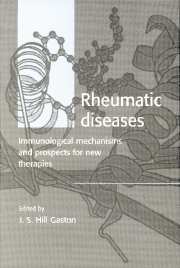Book contents
- Frontmatter
- Contents
- List of contributors
- 1 Implications of advances in immunology for understanding the pathogenesis and treatment of rheumatic disease
- 2 The role of T cells in autoimmune disease
- 3 The role of MHC antigens in autoimmunity
- 4 B cells: formation and structure of autoantibodies
- 5 The role of CD40 in immune responses
- 6 Manipulation of the T cell immune system via CD28 and CTLA-4
- 7 Lymphocyte antigen receptor signal transduction
- 8 The role of adhesion mechanisms in inflammation
- 9 The regulation of apoptosis in the rheumatic disorders
- 10 The role of monokines in arthritis
- 11 T lymphocyte subsets in relation to autoimmune disease
- 12 Complement receptors
- Index
2 - The role of T cells in autoimmune disease
Published online by Cambridge University Press: 06 September 2009
- Frontmatter
- Contents
- List of contributors
- 1 Implications of advances in immunology for understanding the pathogenesis and treatment of rheumatic disease
- 2 The role of T cells in autoimmune disease
- 3 The role of MHC antigens in autoimmunity
- 4 B cells: formation and structure of autoantibodies
- 5 The role of CD40 in immune responses
- 6 Manipulation of the T cell immune system via CD28 and CTLA-4
- 7 Lymphocyte antigen receptor signal transduction
- 8 The role of adhesion mechanisms in inflammation
- 9 The regulation of apoptosis in the rheumatic disorders
- 10 The role of monokines in arthritis
- 11 T lymphocyte subsets in relation to autoimmune disease
- 12 Complement receptors
- Index
Summary
Introduction
Knowledge about T lymphocyte function has expanded dramatically in the 1990s, resulting in many advances in the understanding of the mechanisms underlying autoimmune diseases. T lymphocytes, initially believed to play a small role, if any, in autoimmune disease, are now implicated even in ‘antibody-mediated’ conditions such as pemphigus vulgaris. The undoubted advances in understanding autoimmune diseases have not, however, developed at the same pace for all conditions. More is known about T cell behaviour in multiple sclerosis and myasthenia gravis than in rheumatological conditions such as Sjögren's syndrome, SLE and RA. Indeed there are still claims, with some evidence, that T cells do not play a significant role at all in RA (Fox, 1997). In this chapter, we shall present some of the evidence implicating a pathological role for T cells in autoimmune rheumatic diseases particularly RA and discuss this in the context of recent advances in knowledge of T cell function. We will focus on the potential mechanisms triggering the activation of T cells, and on effector mechanisms. Finally, we will discuss potential strategies for the modulation of the autoimmune response in therapy.
Are T cells involved in autoimmune disease?
Genetic predisposition
Many population, family and twin studies have clearly demonstrated that genetic factors exert a major influence on predisposition to autoimmune disease. Reviewed in detail elsewhere (Theofilopoulos, 1995), the best-defined association is with genes from the class II region of the MHC. These highly polymorphic genes encode cell surface glycoproteins, which present peptides to CD4+T lymphocytes (Trowsdale, 1993).
- Type
- Chapter
- Information
- Rheumatic DiseasesImmunological Mechanisms and Prospects for New Therapies, pp. 13 - 32Publisher: Cambridge University PressPrint publication year: 1999



